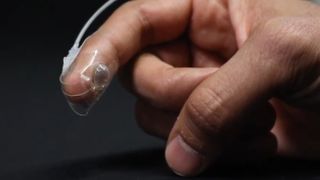Synthetic skin could bring the sensation of touch to virtual worlds
Feel the future

Swiss researchers have developed a wearable, sensor-packed second skin that could let VR users ‘touch’ objects in virtual worlds.
Virtual reality has come on in leaps and bounds over the years, but tactile sensations have been notably by either their absence or their crudity. Thanks to researchers at the École Polytechnique Fédérale de Lausanne's (EPFL) Reconfigurable Robotics Lab (RRL) and the Laboratory for Soft Bioelectronic Interfaces (LSBI), however, this could be about to change.
- Check out our complete guide to the best VR headsets
- We've also rounded up the best VR games
- Here are the best new VR games announced at OC6
In a paper entitled Closed-Loop Haptic Feedback Control Using a Self-Sensing Soft Pneumatic Actuator Skin in the Soft Robotics journal, scientists reveal details of an ultra-thin second skin that could be worn by a VR user. At just 500 nanometers thick, the artificial skin is far more sophisticated and less obtrusive than existing haptic feedback systems.
A series of soft sensors and actuators have been designed to create a realistic sense of touch, something which is helped by constantly measuring skin deformation with strain sensors. The prototype that has been built offers real-time feedback at a frequency of 100Hz frequency and a sensitivity of up to one newton of force.
The magic touch
The lead author of the paper, Harshal Sonar, says that there are medical applications as well as the possibility for use in virtual reality: "This is the first time we have developed an entirely soft artificial skin where both sensors and actuators are integrated. This gives us closed-loop control, which means we can accurately and reliably modulate the vibratory stimulation felt by the user. This is ideal for wearable applications, such as for testing a patient's proprioception in medical applications."
The skin is made of silicone and electrodes comprising a liquid-solid gallium mixture. Pneumatic actuators, which can be pumped with air, provide feedback to the user.
The skin is thin enough not to interfere with movement, and while for now the prototype is limited to a finger attachment, it's hoped that future versions with progress to something much larger.
Get daily insight, inspiration and deals in your inbox
Get the hottest deals available in your inbox plus news, reviews, opinion, analysis and more from the TechRadar team.
Sonar says: "The next step will be to develop a fully wearable prototype for applications in rehabilitation and virtual and augmented reality. The prototype will also be tested in neuroscientific studies, where it can be used to stimulate the human body while researchers study dynamic brain activity in magnetic resonance experiments."
Via Tom's Guide

Sofia is a tech journalist who's been writing about software, hardware and the web for nearly 25 years – but still looks as youthful as ever! After years writing for magazines, her life moved online and remains fueled by technology, music and nature.
Having written for websites and magazines since 2000, producing a wide range of reviews, guides, tutorials, brochures, newsletters and more, she continues to write for diverse audiences, from computing newbies to advanced users and business clients. Always willing to try something new, she loves sharing new discoveries with others.
Sofia lives and breathes Windows, Android, iOS, macOS and just about anything with a power button, but her particular areas of interest include security, tweaking and privacy. Her other loves include walking, music, her two Malamutes and, of course, her wife and daughter.
Most Popular


